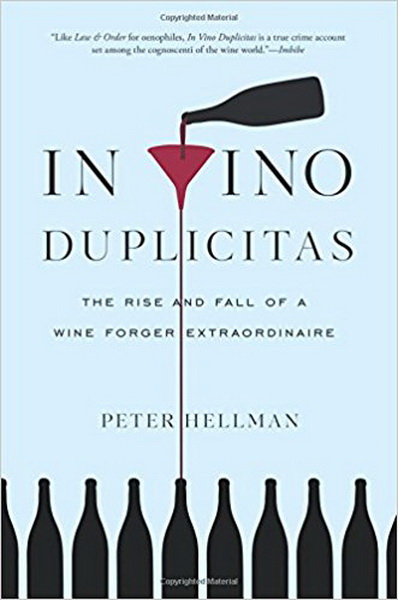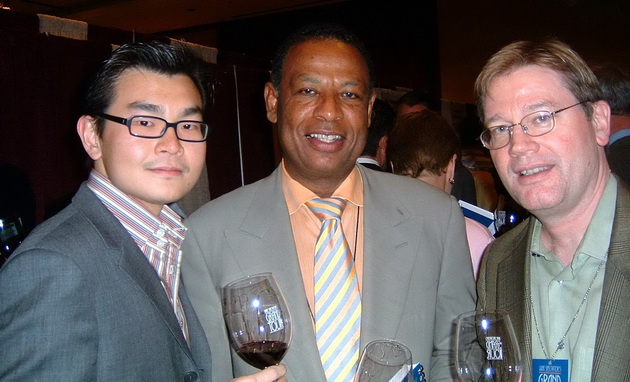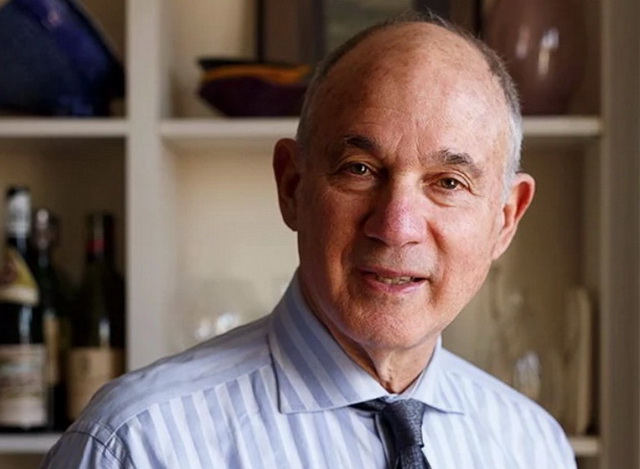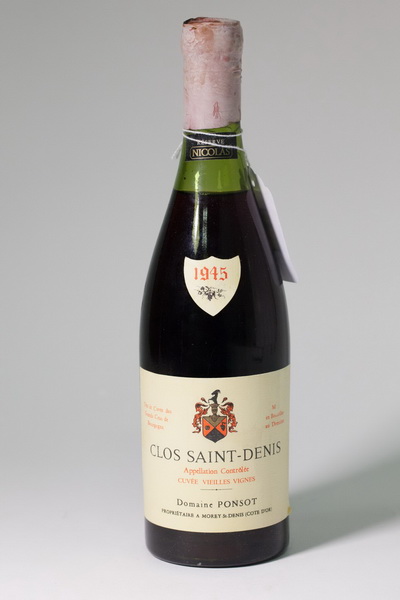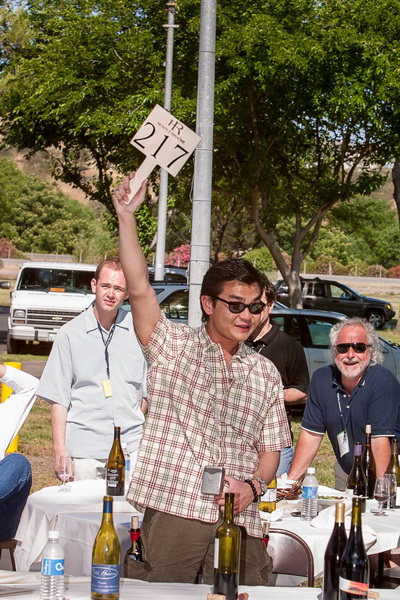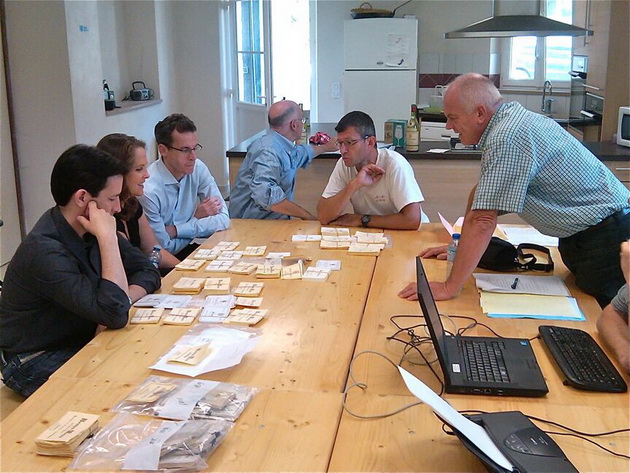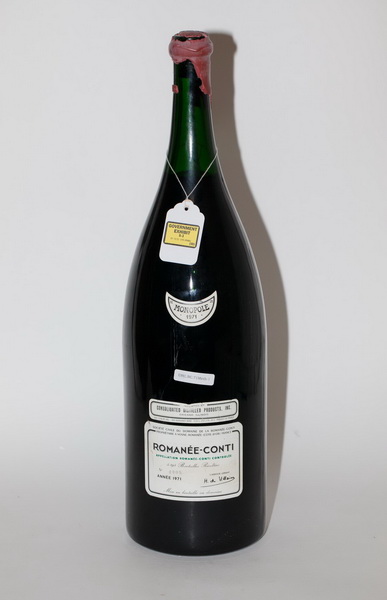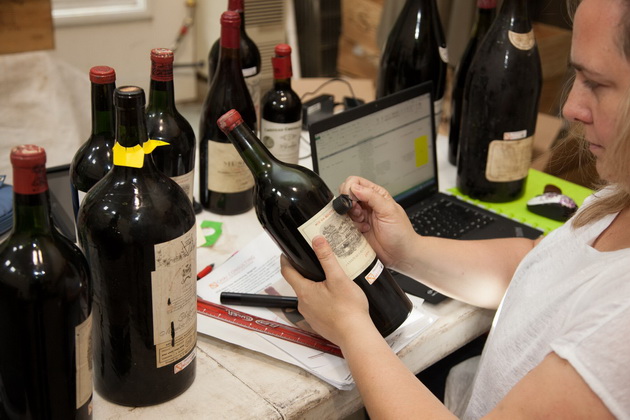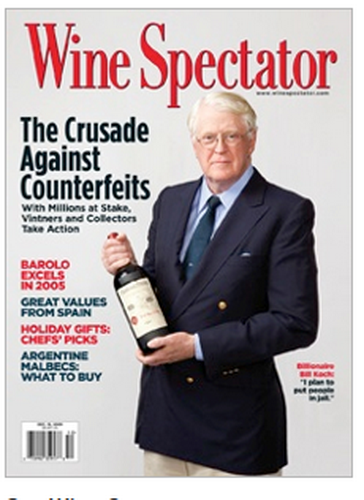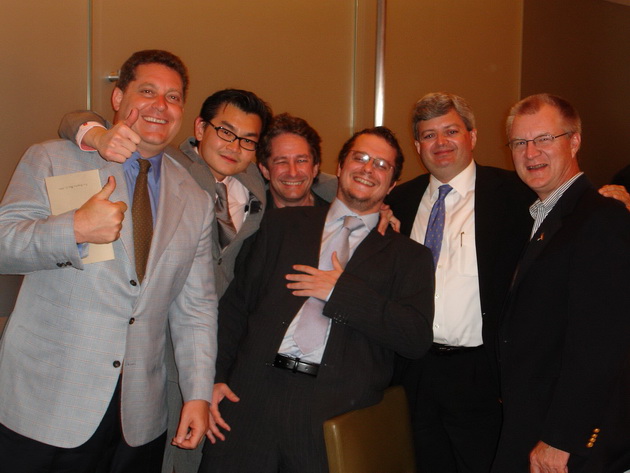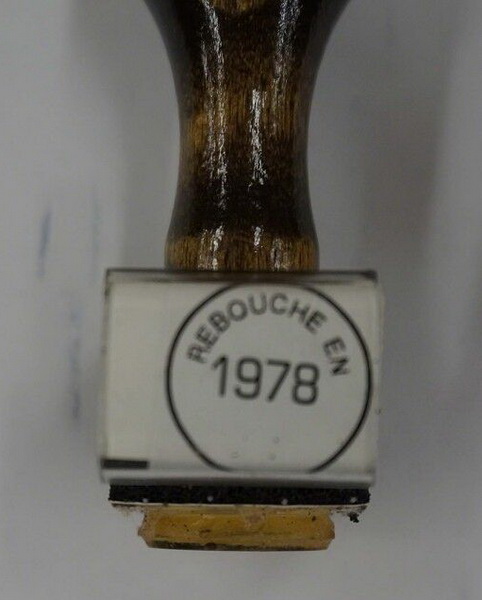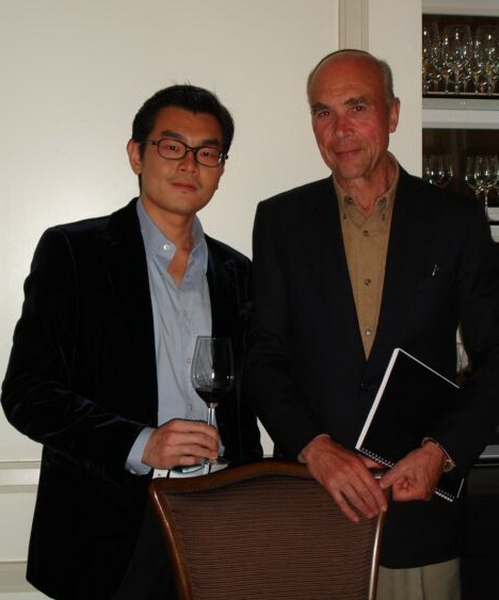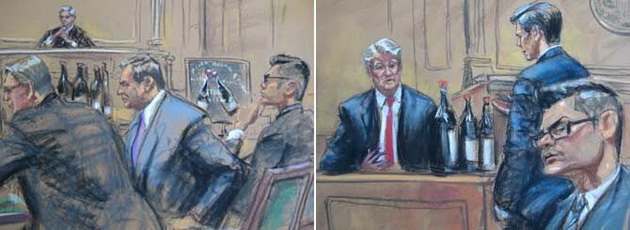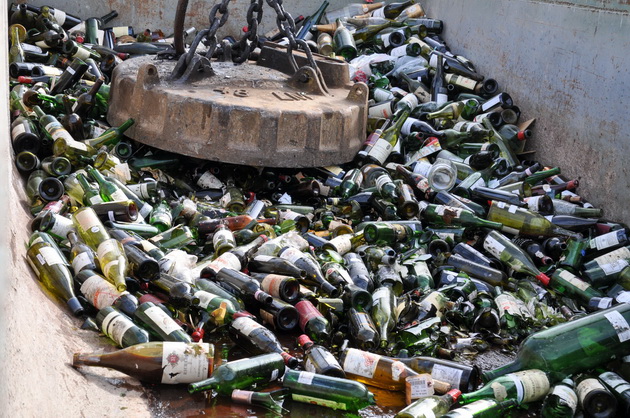On last night’s Sunday Sipper Club at 6 pm eastern, we chatted about the shadowy world of wine forgery with New York Times journalist Pete Hellman!
Why is wine such a popular target for fakes?
Who are the criminals who forge these wines?
How do you know you’re drinking a fake wine?
Pete Hellman’s new book, In Vino Duplicatas, dives into the underworld of wine forgery in the best tradition of journalistic exposé and gripping storytelling:
www.nataliemaclean.com/blog/videos/in-vino-duplicitas-pete-hellman-wine-forgery-video
Join us Sunday, March 25th 6:00 p.m. EST, for our video chat What’s New with California Wines, with author Marnie Old and French vintner, Jean-Charles Boisset.
Want to know when we go live?
Click on “Get Reminder” on the page below:
Watch previous episodes of the Sunday Sipper Club (SSC) and find out who’s coming up next.
Paul E Hollander0:00 I was at a Barnes and Noble bookstore yesterday and was looking at this book. Then, you mentioned it on Sunday Sippers!
Stephen Andrews0:00 If you subscribe to net flex watch the documentary Sour Grapes. Good intro to reading the book. Introduces you to Rudy.
Bartholomew Broadbent38:28 I can’t wait to read Pete’s book, will order it tonight and give it to my father for his 91st on May 2, after reading it myself
Peter HellmanI used your dad’s tasting notes extensively in writing my book. They can’t be beat for concision and lack of stuffiness!
Lise Charest Gagne20:02 Hello Miss Natalie and Pete – I loved the show..i bet this has been happening for some time all over the world
Marcia J Hamm32:21 “Sour Grapes” on Netflix tells this story and it’s crazy to think that this “kid” was so incredibly convincing to others!
Ted Lippman48:18 A wise supplier friend from Banfi, Victor Vittori, says ” You should have a wine cellar, not a wine cemetary”
Bartholomew Broadbent42:16 He used me as cheap child labor to pack up the wines for auction!
Bartholomew Broadbent24:54 Alleged, Hardy Rodenstock, not proven but probably
Lois Gilbert18:32 If the wines had actually gone up for sale, would the auction house hold any liability?
Andrea Shapiro52:54 Wonderful interview! So educational and exhilarating to understand and experience some of this underbelly of the wine world!
Jenn Havers22:33 I’ve read it!! What an amazing story and so great to hear the story from you directly Pete!
Deborah Podurgiel45:47 Love it! *(* Will be ordering your book. Cheers.
Bartholomew Broadbent32:58 Good story but my father sued the Publisher of The Billionaire’s Vinegar for defamation and libel and he won that case. The book is not allowed to be sold in Europe. The book is a good read but there is a lot of inaccuracies in that book and a lot of blatantly wrong information. Still a good read.
Neil Phillips46:31 Wine is an investment in future happiness with friends.
Bartholomew Broadbent43:34 Looks like he’d drunk most of the bottle!
Jeffrey L. Johnson31:20 Great show,, Thanks for your advice
Lise Charest Gagne46:50 Pete or Natalie could you post Pete’s wine he is drinking for us ![]()
Marcia J Hamm40:30 Have ordered this book on audio from my local library!
Jane Staples16:22 Can’t wait to read the whole book!
Ronald John Benzie21:55 In vino dupliticas Great name
Alan Cameron14:03 What a great story !!!! A great story teller too !!!
Neil Phillips2:30 Just ordered the book, Pete…welcome.
Andrea Shapiro21:54 Are there many new world wines that have been shown to be counterfeit? If so, which regions?
Neil Phillips43:48 Bartholomew, YOU should be a good guest one Sunday. ![]()
Neil Phillips21:14 I just hate it when I lose receipts for the $12K bottles of wine I pick up…. ![]()
Lise Charest Gagne38:28 i loved the show – now i need the book
Jeffrey L. Johnson17:09 We will be ready for the book!! LOL
Jerry Wettlaufer38:22 I saw the Sour Grapes doc too. Crazy.
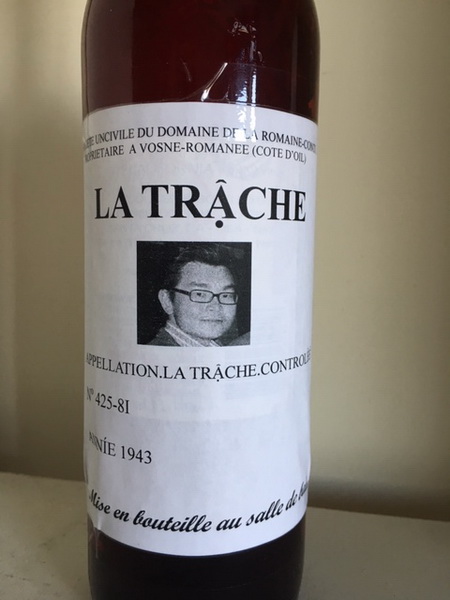
Peter is a New York-based wine journalist and best-selling author. His writing has appeared in Wine Spectator, The Wall Street Journal, New York Post, New York Times, New York Sun and others.
Books include bestselling Chief!: Classic Cases from the Files of the Chief of Detectives and When Courage Was Stronger than Fear.
Magazine journalism highlights include the first major profile in the American press (New York Times) of Serge and Beate Klarsfeld and their search for justice for Nazi victims in France; and the real estate cloak-and-dagger story of the Manhattan assemblage of the Citicorp Center (New York Magazine).
Peter started writing about Rudy Kurniawan in 2008 and has covered the story ever since. He has two adult children and lives with his wife, Susan, in New York City.
Transcript
Pete Hellman: You know it says, my friend Peter (inaudible) for instance pointed out and says it in the book that his father collected Picassos, which he had to insure and spend a lot of money insuring and worrying about whether or not they would get stolen, but Peter says, you know, you drink a wine and then you have the memory. No insurance is required.
That’s true. Very true.
Pete Hellman: Five minutes.
Yup We’ll start to count down.
Pete Hellman: Well, we could watch some Highland dancing.
Yeah, right, in our leisure time here Oh dear. Let’s see.
Pete Hellman: Now, do we know if I’m echoing on your?
Natalie: Nope, yes, we do know, and it should not be echoing.
Pete Hellman: Good.
It was on my side, it was definitely on my side, and then I tested it with my mother and it’s all good.
Pete Hellman: So what did you do to fix it?
I was doing, I was getting audio from two sources which is always.
Pete Hellman: So, maybe I was giving you audio from two sources.
No, it was me, it was on my side. It was not you
Pete Hellman: Okay, I’m usually the guilty one, whatever goes on.
That’s very generous. Not in this case.
Pete Hellman: If it does, it would be great if we don’t have that echo.
Oh, yeah, and I’ll ask people as we’re live but it should not be an issue this time.
Pete Hellman: I have a cute thing to kind of show you, just so you’ll know. I don’t know if this’ll work in.
Sure.
Pete Hellman: My brother-in-law, who is a and I’ve done the most important thing, Natalie.
Natalie Okay, what’s that.
Pete Hellman: Which you didn’t even tell me to do. And I thought to do it.
Natalie Okay, good.
Pete Hellman: There’s a phone on this desk and I pulled the plug on that.
Excellent, you’re right.
Pete Hellman: Yeah.
For things ringing in the background. You’re right.
Pete Hellman: In real life, it’ll start ringing as soon as we go live.
It’s true, it will happen. Alrighty, we are good.
Pete Hellman: That’s a nice sound.
Yes, just getting ready with my little props.
Pete Hellman: Did you actually just uncork a bottle?
Natalie Yup, the Faiveley.
Pete Hellman: Oh. So that’s the sound that my spectator uses for his videos.
Oh, does it?
Pete Hellman: Yeah, when you start any of their hundreds of very good videos, they pop a cork and you hear that sound.
That is awesome.
Pete Hellman: Trickle, trickle, trickle.
Everything’s working really well because they are starting to countdown on Facebook ’cause I have it scheduled so this is good. Everything is working. Knock on whatever.
Pete Hellman: Knock on whatever.
So, as I’m introducing you, they won’t see you but they can hear you, it’s like we did in the practice run, and he joins me live now from his home in New York City, welcome to the Sunday Supper Club Plate. That’s when they’ll see you.
Pete Hellman: Okay.
All right, so, I will do a moment of quiet, but we’re still two minutes and 13 seconds.
Pete Hellman: Okay. So, is this channel, I didn’t know you could do this on Facebook.
Yeah, it’s new, relatively new.
Pete Hellman: And what do they call it?
They call it Facebook Live.
Pete Hellman: Oh, okay, that makes sense.
Yeah, absolutely.
Pete Hellman: Where’s your mom live?
She’s in Halifax, where I grew up. Nova Scotia.
Pete Hellman: Oh!
Yeah, highland, Scottish, all the way.
Pete Hellman: Wow. We’d have dear friends on PEI.
Oh, that’s a beautiful part of the world.
Pete Hellman: Yeah, house on the north coast, not too far from the seven gables house.
Oh, yes. Wonderful.
Pete Hellman: Did you read that as a girl?
I did, oh yes, I liked Anne and her spirit. Feistiness with the cracking over the head with Gilbert!
Pete Hellman: I never read it, but I better do it now.
Ah, yeah, it’s well written. All right. This is good, we’re one minute, all’s good.
Pete Hellman: By the way, I turned off on this camera, to follow my face because it kept going back and forth and so it was terrible.
No worries. You’re all well-centered, everything, and if you look at, as I said, the eye of the camera of your Logitech, you’re looking at the viewer, and it opens up your eyes and opposed to down. It’s all good.
Pete Hellman: Okay. Hypnotize the Logitech.
Oh dear. All righty, and I will, okay, so we’re 15 seconds, I’m going to go quiet now, we’re all good, this is going to be a lot of fun.
Pete Hellman: How long’s it going to last?
30 to 40 minutes.
Pete Hellman: Okay.
Okay, we’re 8 seconds, so I’m going to go quiet now. All right, well, you may enjoy wine, but have you heard about the mysteries in the wine industry? In terms of wine forgery. Bottles, famous bottles of wine, that were faked or forged and connoisseurs at auction and other places were duped into buying these forgeries which were basically worthless.
That’s exactly what we’re going to learn about tonight, on the Sunday Supper Club. I’m Natalie MacLean, editor of Canada’s largest wine review site at nataliemaclean.com and we gather every Sunday night at 6 p.m. eastern, that’s Toronto New York time, to talk to the most fascinating people in the world of wine.
Now, before I introduce my guest fully, in the comments below, just yes or no, have you heard about any of these wine scandals? Have you heard about these famous fakes that were produced? As I said, duping wine consumers and connoisseurs out of hundreds, sometimes thousands of dollars. Yes, or no, have you heard about these stories? All right, and if you take a moment Bartholomew Broadbent is in the house, so is Beverly Asleson.
Pete Hellman: Oh my goodness.
And I can’t keep our guest quiet.
Pete Hellman: He’s an important guy in the wine world.
Excellent.
Pete Hellman: As is his father.
So, I haven’t even introduced my guest and he’s recognizing people who are here tonight. Jerry Wetloffer, he’s drinking a very authentic, real Ravine Vineyards from Niagara. Louis Gilbert is, yes, she’s heard of these fakes, but they’re not in her price range. And Paul is here from Virginia with Patty. Welcome guys. Okay, let me get to introducing our guest who is going to be an absolute delight.
Pete Hellman: And I’m the son of Virginia, so.
You are still off-screen, Pete
Pete: Whoops, sorry. I’ll shut up!
No, no, I’m going to introduce you now. This is great, all right, so, our guest tonight is a New York City based journalist. He’s written for the New York Times, the New York Post, Wine Spectator, and a number of other prestigious publications. He has a number of books, but the one of course that we’re going to talk about tonight is In Vino Duplicitas, it’s a New York Times best selling book, it’s just come out. In fact, they had to go back for another print run. It’s sold out, it’s so good. Very gripping story in the best tradition of a journalistic reporting, but also fascinating story telling. The man who wrote the book, the journalist, he joins me now, live from his home in New York City, welcome to the Sunday Supper Club, Pete Hellman, hello!
Hello, big pleasure now that I’m with you.
All right, awesome, terrific. Look, people are just piling in here. Pete, Jane Staples is here with her genuine, everyone’s playing off this, everyone’s saying they have a real wine in their glass tonight. Her genuine Jip Jip Rocks Shiraz. Bartholomew says he’s in Virginia too right now. Neal Phillips just ordered the book, Pete, welcome. And we will be telling you where you can get Pete’s book. Pete, hold it up right away, why don’t we get right into the little promo moment.
Okay.
There you are.
Over my very handsome face, my romanced cover.
There you go, In Vino Duplicitas, I assume, Pete, that this is available in all the online bookstores, physical bookstores.
It is indeed.
Good.
It was distributed in Canada as well.
Yeah.
Amazon is where most people go, but you can go to your local bookstore. I always like to support the local bookstores, so if they don’t have it, they will order it.
Awesome. Welcome Andrea, hello, and Ann MacLean. You guys are just, and as I said, the comments are coming in so quickly that if I miss yours, please repost it again and I will acknowledge and of course funnel questions to Peter. You should know, that if you do get people on board here. Bartholomew says my father is waiting for me to call him at 6 p.m., but I decided to watch this first.
All right.
I’m honoured. And I just must say, Bartholomew, your father’s books of the wines he has drunk, I think now there are two, actually three, are the best source of tasting notes there ever was or ever will be.
Wow.
Magnificent taster. So, I’ve had some pretty good wines out of your shop, too, from Portugal and elsewhere.
And that father would be the Michael Broadbent, correct?
Yes, who single-handedly got the wine auction business going back in 1967 or so.
Was that with Christie’s?
You bet.
All right, we’re on fire. Bartholomew says thanks. Okay, let me just make sure that we are not, Beverly says there might be an echo here. Is anyone else getting the echo? Hopefully I have eliminated that. 1966 says Bartholomew. Okay, so, we talked about this before in our little mini-chat, Pete, but why is wine such a great product, if you will, for forgery, versus say, an Hermes scarf. Maybe tell us what makes wine a great target for these criminals.
Well, if you have a criminal mind, Natalie, and of course, nobody listening does, so we’ll just say hypothetically, if you decided that from home you wanted to have a ‘do it yourself’ counterfeiting project, well you can’t do a Rolex, that’s out of the question. That’s just too hard. You might be able to do a multi-colored, silk screened, Hermes scarf which could cost 400 bucks or 500 bucks at an Hermes store. You might, if you’re very good at it, you might make a pretty good representation of an Hermes scarf. But somebody who really is an expert would pick it up and feel the fiber and say, nice try, but this isn’t the real thing. Wine, is of course, luxury wine is, can be much more expensive than four or 500 dollars. The great thing about wine, old wine, mythic vintages of old wine for counterfeiting is that the wine is locked in the bottle. You can’t really know if it’s the real thing or not until you pull the cork. And that may be months or years after you actually have made it or purchased it, so if there’s a good job on the label, and the cork seems right, and the coil looks right, and the bottle looks right, there’s no way you can know if it’s counterfeit or authentic until you pull the cork, and that’s unique to wine.
Okay, so, people are loving this already. They’re saying there’s an echo when we’re on screen together but not when you’re alone. So Pete, when I ask you a question, I’m going to go to you on a single shot on you alone. They don’t get the echo there. We’re just going to, from…
Pete: All right.
…one shot to the other and it should work. All right, so, this is a fascinating story. Maybe tell us what drew you to this particular story in the first place. Of all the different things that are going on in the wine world, scandals or not, why did you get intrigued by this story?
This story actually, I’d like to say I’m a great investigative reporter and my nose stood out. But in fact, one Friday afternoon, April 25, 2008, I just came back from the gym and I got a call from a fine wine dealer, Jeffrey Troy, who said to me, you should go down to the Acker, Merrall, and Condit wine auction at Crew at 6 p.m. This is now about 5 p.m. I said, “why”? And Jeffrey said, “something unusual is going to happen”. I said, “what”, and he said, “22 lots of a very sought after Burgundian Domaine, Domaine Ponsot, are going to be withdrawn from the auction at the demand of the fourth generation proprietor of Domaine Ponsot, Laurent Ponsot. And Laurent Ponsot is even flying in from Burgundy to make sure these wines are withdrawn because Ponsot says they are fakes”.
I thought well, that’s interesting, I better go down to Crew, which was then had the greatest wine list of any restaurant in New York, specializing in Burgundy, at about 3,500 Burgundies on its wine list. Most of them were the month or six months salary for most people. I took a shower, I got dressed, I went down there, and sure enough, midway through the auction… Wine auctions go very fast because it’s not like Picassos. You have to sell a lot of wine in a short time to make it really worthwhile. And midway through this auction, the auctioneer John Campeon, paused the action and said, well, “something’s a little unusual here. At the request of the Domaine, Domaine Ponsot, and with the consent of the consignor, one Rudy Kurniawan”, he did mention that name, “I’m withdrawing the next 22 lots of Domaine Ponsot wines”.
At which point there was an uproar in the audience because many people had come from as far as California to bid on these wines. A lot of curse words were said. And I have to tell you, at Acker auctions, great bottles are passed around liberally. The auctioneer had learned that the more people drank, the more likely they were to hold their paddle up and bid more than they had expected to before they drank too much wine. So, it was a good deal to have people drinking.
Anyway, why had these lots of Domaine Ponsot wines been withdrawn? Well, it’s, to be exact, there were about seven lots of one of the 32 grand crus of Burgundy, Clos Saint-Denis, and they were listed in vintages 1945 through 1971. These were mythic vintages, great vintages of Burgundy, and a few people who collected Ponsot wines noticed this and they were puzzled because they said… one of them, by the way, was Michael Rockefeller of the Rockefeller family. Kind of had to be a Rockefeller to pay for these wines. These collectors said we’re always on the lookout for Domaine Ponsot wines, especially Clos Saint-Denis and we’ve never seen any from the vintages listed, 1945 through 1971. And so, they called Laurent Ponsot at his winery in this little sleepy town of Morey St. Denis and Ponsot later told me. Wow, when I heard that, I was glad I was sitting down because otherwise I would have just fallen down.
The reason for that was, Laurent Ponsot knew that his father had never gained access to Clos Saint-Denis until 1982. So, open and shut case. There could not be 1945 through 1971 Domaine Ponsot Clos Saint-Denis. So, yeah.
That gripped you, like, that was big news at the auction. Why did you say, wow, this is a story I need to pursue. There’s something going on here that’s much bigger than just auction pulling off the latest bottles.
Well, yes, and the first thing was, this was a period of rapidly rising wine prices. Wine prices had been rising since around 2002. This was a time when there was a lot of loose money around on Wall Street. After young guys who made a couple of million said to themselves, wow, I bought the new Maserati. I bought the new condo on the beach. I bought the new Rolex, so what else am I going to buy?
Their thoughts often turned to aged wine. In this case, and so as a result, there were a lot of questions about which wines were counterfeit. It was known there were counterfeits out there, but no one could be sure. They would look at the bottle, they would say, ah, well, I don’t know, the label doesn’t look quite right and da-da-da-da. But it was never sure.
Here was a case with the Clos Saint-Denis, open and shut, could not exist. Domaine Ponsot had no access to these wines until 1982. So, I was at this auction, as I say, and an answer to your question, I asked the wine director, Robert Boor, after the auction. I knew it was Rudy Kurniawan was the consignor of these wines, the ones who were opened and offered them. I said, “is Rudy here”? And Boor pointed to us a little guy over in the corner who was kind of quiet over there. Normally, Rudy Kurniawan liked to circulate, but he knew something bad had just happened, with the withdrawal of those wines.
And normally, as a journalist, I don’t try and be undercover. I identify myself. This time though, I decided I’m not going to identify myself. I’m going to let him think I’m a collector. And I walked over to him and I said, hey Rudy! And he looked at me and I see he’s trying to think “where have I met this guy”. He had not met me. I said, Rudy, what happened with those 22 lots of Domaine Ponsot? And I saw in him thinking behind his black rimmed glasses, what am I going to say? Finally, he says, “well, we try our best, but it’s Burgundy and, pardon the expression, shit happens”. So, I hope none of your listeners will take offense. But that’s what he said. And I went off to another corner and I wrote down those words in my catalog that’s still there and that was the last thing Rudy ever really said in public or to any reporter about those withdrawn lots.
And so, I write the Wine Spectator, I gave a call to my editor there. I said, “hey Mitch, something interesting happened last night at this auction at Crew. These 22 lots of Domaine Ponsot were withdrawn”. And he said, “yeah, go do a story about that”. And that was the beginning, I had no idea at the time, of an eight year saga in which many things happened. I could jump to the end and tell you Rudy Kurniawan, who drank wine day and night, the greatest wines in the world, unfortunately is behind bars now in a federal prison and not able to drink anything.
I have to just tell you Pete, people are just loving this story. Allen Cameron says what a great storyteller you are. Andrea says truly fascinating. Jeffrey Johnson, awesome stuff, thanks.
Pete: Wow.
Ron Benzi says great story teller. Jeffrey Johnson wineandvine.com here, lol, not sure if understand the context, but I’m sure you do.
Pete: Well, that’s a publication.
Okay, got ya, sorry, I should know that. But that’s a great story and I hesitate to interrupt you, but keep going, so where did it go from there?
Well, I did write a story for Wine Spectator, and Laurent Ponsot explained to me that he could have very easily let these wines, I should say, the wines were offered in the catalog, the 1945 to ’71 for up to $60,000 per case. $60,000, that’s a lot of money. For most of us. Laurent Ponsot said I could have let go on for sale and the name of Ponsot would have still been very big and people would have respected it, but he said the thing to me that was the most powerful and goes to the heart of why people make wine in a particular place.
Laurent Ponsot said this is my earth and this earth and Burgundy is capable of incredible variety of flavors and nuances and aromas and age-worthiness, and I didn’t want to see that prostituted. So, he came, flew in here, got here, I arrived at the auction maybe 10 minutes after it started. I didn’t know Laurent, but he did walk in 10 minutes after me and took a seat. Everybody was convivial and drinking their wine. He was just stony faced. He wanted to make sure that wine was withdrawn.
The next day, there was a lunch at a very fine restaurant here in New York, Jean-Georges, and there were four people at the table, maybe five. Let me see. John Kapon, the auctioneer, who had to withdraw the wine. Laurent Ponsot who had come in to stop the auction of that wine. A very fine Burgundy connoisseur named Doug Barzelay. And the fourth person was Rudy Kurniawan. And about midway through that lunch, Laurent Ponsot, who is a courteous man, looked over at Rudy and said, “Rudy, I need to know where you got that wine. Who you bought it from.”
And at that time, Rudy Kurniawan who was not yet, maybe he had just got to become 30 years old, was probably the largest purchaser of wine on Earth. He himself boasted that he was fine. He said from his wealthy family in Indonesia, he had an allowance of a million dollars a month, and Rudy said, I can never get to the end of the month before it’s all spent. Most of it’s spent on wine, although he spent a lot on restaurants and fancy clothes, and so on. And so when Laurent Ponsot asked him this question, “Rudy, where did you get that wine”, he assumed, like most people assumed, that Rudy was buying so much wine, some of it inevitably must be counterfeit because everyone knew there was counterfeit wine floating around. And Laurent Ponsot was a great label to counterfeit because it was so valuable and Rudy said at that point, something a little unsettling to Ponsot, he said, “well, Laurent, you know, I buy so much wine, I really don’t know where I got that wine”. Ponsot said, “but you must have receipts”. “Oh no, I throw my receipts away. I don’t keep them.”
And this didn’t satisfy Ponsot. But he pressed on and Rudy Kurniawan promised that he would go home to Arcadia, California, where he lives, just outside of L.A. and see if he could figure out where he got that wine. Ponsot said to me afterwards, well, Peter, you know, if I buy a Maserati, I’ll remember where I got it from. He was equating his own wine with a Maserati. It’s about equivalent in price. And so, it didn’t sit well with Ponsot that Rudy Kurniawan dissembled and couldn’t quite nail where he got the wine. As we will learn, maybe in this conversation, there was a good reason he couldn’t say. So that was the start for me, and I didn’t imagine after the first article I wrote about that auction on April 25, 2008, I thought that was kind of a one-all. Okay, this thing will fade away, but eight years later, I was still writing about Rudy Kurniawan.
To just take a little break here ’cause you are a master story teller. I could just let the camera run on you and people are loving it. I just have to give you some feedback from what’s coming in because I know you can’t see the comments. Jeffrey Johnson will we be ready for the book. Jeffrey, there is a book, so In Vino Duplicitas, Pete’s book.
Pete: One more time.
There you go. Says she can’t wait to read the whole book. Heather Proctor said, Pete, you’re competing with exciting golf. So you’re winning this round, so to speak.
Pete: Wow.
Well, we got golf going on downstairs, but this is a better conversation.
I was a caddy when I was 13 years old, so I don’t need golf.
Says hello Miss Natalie and Pete, I love the show, I bet this has been happening for some time, and now around the world. Neal Phillips says, I hate it when I lose receipts for $12,000 bottles of wine. I know, right, where did I put that $12,000 receipt. Paul Hollander so–
Pete: Very good question, where did you put it?
Exactly, Paul Hollander, so fascinating. Wonderful storytelling. Andrea Shapiro, “are there new world wines that have been shown to be counterfeit”, yes. And somebody else, Lee says “I have to add that book to my wine library”. Ronald Benzi says, “In Vino Duplicitas, a great name”. So guys, again, the comments are flying off the screen, I can’t keep up with them. But please keep reposting and we will acknowledge. Ronald’s listening in from Sydney, Australia. I love how this brings us all together.
What time is it in Sydney, Australia, what day is it in Sydney, Australia?
It must be tomorrow sometime. And Jen Haver says “I’ve read this book, it’s an amazing story, it’s so great to hear directly from you, Pete. Fantastic”, wow, okay. Pete, let’s see, now this topic is a hot one. It’s an expose so to speak about criminal activity. What were your major obstacles in telling the complete story and getting to this finished book?
The main obstacle for me, well, I did write about Rudy. I probably wrote between online stories and stories in Wine Spectator magazine, 25 stories about Rudy. And these stories covered various aspects.
I have to just stop here and say there’s a couple of heroes in this story. One is a very young, was at the time, still is, a very young assistant United States attorney here in Manhattan, southern district of Manhattan. His name is Jason Hernandez, and he’s a true wine lover. Has his wine in perfect storage here. Really a wonderful taster. He knew about the Rudy Kurniawan story and also about a previous counterfeiter, Hardy Rodenstock.
That’s another whole story, and then there’s another hero here, and that’s Bill Koch, one of the four Koch brothers, depending how you look at it, the famous or infamous Koch brothers. This one is a remarkable guy. Bill Koch is the twin of David Koch and they of course, four brothers, inherited a huge fortune from their father, a great oil field engineer and refinery engineer.
Bill has been a huge collector of wine, and he discovered, quite a few years back, that his cellar was infiltrated with fakes. A number of them could be traced back to Rudy Kurniawan, the auctioneers. Bill sent investigators, former FBI agents, former CIA agents, former national security agents, all over Asia to learn what he could about Rudy.
Rudy was born in Indonesia, he is an ethnic Chinese of Indonesian nationality. He came here to go to school, to go to college, Cal State Northridge. Did very well, got a degree in accounting. Aced most of his courses and maybe this is the moment just to say how this all started.
We’ll get back to the other. Rudy says, has told People, that he knew nothing about wine until a birthday dinner for his father at Fisherman’s Wharf in San Francisco, probably in 1999, possibly 2000. At this dinner, Rudy, he picked the most expensive wine on the wine list at this restaurant. It was Opus One. I’m guessing that the price on the wine list was probably $300. When he tasted this wine, it just kind of opened a sensory circuit in his brain, in his nose, in his palate, he just flipped out over this wine. He didn’t know wine could be what he was tasting.
When he went home, he began to buy every bottle of Opus One that he could find in the L.A. area, and from that wine, he went on to other so called cult Cabernets from the Napa Valley, wines where you had to be on the waiting list or you even had to be on the waiting list to get on the waiting list to buy the wines.
From there, he went to Australia and Shiraz, big Shirazes, like these big Cabs, and from there he went to Bordeaux, somewhat more refined, less impact. And from there he went to the ultimate category, which is red Burgundy.
It turned out that Rudy had an extraordinary palate. Just extraordinary. He remembered everything he tasted. He could distinguish between lines. If he was drinking a meritage, which is to say like a Bordeaux blend of four or five grapes, he could actually pick out the grapes. I say he could do that. Some people say they could do it, and it’s baloney, but all the good tasters I know who tasted wine through Kurniawan, praise his ability to identify wines, blind.
Have to tell you a little story here, real quick. Rudy, for reasons we’ll get to, did not invite people to his home. But he held tastings in expensive restaurants. These were blind tastings and each person who was there would have 12 bottles, 12 glasses put in front of them, no identification as to what the wine in the glasses was. Rudy himself could always nail 10 out of 12, I was told.
One of the test taste, one of the collectors who tasted there became suspicious. He said, there’s no way Rudy is really nailing these wines blind, identifying them without any knowledge. He must be paying 1,000 bucks to somebody in the kitchen or the wine director to write on the bottom of the napkin what the names of the wines are or something like that. So, this gentlemen, Jeffrey Levy, said, I’m going to fix Rudy. I’m going to have a tasting in my house, and I’m going to control everything. There is no way Rudy could ever know what the wines in the 12 glasses are. And so, he invited Rudy to his house, and the famous set-up just as he had planned, and Rudy went through the 12 glasses, and guess what, 10 out of 12, same thing. And this collector said and he was very close on the other two.
So, Rudy had this ability, and that put him in good stem with wealthy collectors. They respected him, and now that I know I’m going on here a bit, but one of the key things about Rudy was, he was basically a nobody. Hate to say that, but he wasn’t, he was, got his accounting degree, he was doing little jobs here and there. Suddenly, he would go to wine tastings with wealthy, mostly older people, and he brought great bottles with him. Not just single bottles, not 750s, magnums, double magnums, even bigger bottles. These were very expensive wines, and of course, when you bring the big fancy bottle, people invite you back, and they invite you to their own tasting, and so that’s how Rudy really entered the circles of very wealthy, king pins of industry, Hollywood, real estate, and he did it by being really generous with the wines he poured.
Fascinating, it’s almost like, this is a made for Hollywood movie. With these guys who make it in Vegas and they come from nothing and they showcase their skills. Bartholomew says, “fascinating story about how Rudy got in there and trusted by all of these connoisseurs”. He also refers back to a comment, alleged, Hardy Rodenstock not proven but probably. I think, correct me if I’m wrong.
Pete: That is correct.
That is The Billionaire’s Vinegar book?
Pete: Yes.
That’s the Bill.
Wonderful book.
Yeah, another wonderful book, Billionaire’s Vinegar. But this is the more recent update of another wine story. Gwen Barton says hello, Jeffrey is heading off to Books-A-Million to buy your book. What was the most surprising thing you learned while researching and writing this book, Pete?
I think the thing that was most striking, is how different these very old wines are from the wines you and I drink everyday. Rudy, the rarest of all wines that Rudy, I’m going to go back one step and say, the most striking thing was how easily Rudy was able to flimflam, seduce, very sophisticated captains of industry. I won’t name him here on the air, but he’s named in the book. The founder and chairman of Petco, the great pet food store chain. Rudy just wrapped this guy around his finger, sold him millions and millions of dollars worth of fake wine.
Another one, I will say his name, David Doyle, a billionaire from the tech world. Here’s an example of Rudy. Rudy offered David Doyle seven bottles of probably the most sought-after Burgundy of the last century, and that’s Romanée-Conti 1945. That was the last year that the so-called pre-phylloxera vines, that is, vines that were not, the last vineyard in France probably, well, there probably were few others, but this phylloxera mite attacked the roots of all French vines in the 1880s, late 1880s, and by the 1990s, all the vines in France were dead. Were killed by this little mite which was microscopic but could eat the roots of the vine. The last vineyard that really survived by enormous effort and care and TLC of its owners, was, Romanée-Conti, the most famous vineyard in France, certainly in Burgundy.
In 1945, 806 bottles of Romanée-Conti were made, that was all, and then the vines were rooted up and the vineyard was replanted, and there was no more Romanée-Conti for about seven years. What happened with those 800, 803, and 806 bottles. Surely, the best restaurants in France took all they could get. A few American suppliers probably got a few. How many were left by the turn of the century? Almost none, if at all.
Rudy, nevertheless, offered seven bottles of 1945 Romanée-Conti to David Doyle, and David Doyle bought them. He paid I think $14,000 a bottle. Had he called to the domaine, or Romanée-Conti, and asked the coproprietor Aubert de Villaine, the most famous vintner in Burgundy, “Mr. de Villaine, do you think it’s possible that this young guy here wants to sell me seven bottles of Romanee-Conti, 1945?” What do you think about that? Aubert de Villaine would have said, as he had said to me, I wouldn’t know where to get a single bottle on this earth of 1945 Romanee-Conti.
So, in answer to your question, I think, Rudy was a conman like Bernard Madoff, and the thing about conmen is, they know how to push buttons in people. There was a book in 1960, came out in 1960, I think, by maybe an anthropologist named David Maurer. It was called The Big Con, and he followed around master swindlers, conmen, who would strike up conversations with strangers and before long, they had the stranger’s money. David Maurer says the one thing that he learned from all these master conmen was they’re very proud. They say they do not take anyone’s money. You thrust it into their hands. That’s what Madoff did. People begged him to take their money and invest it.
People basically begged Rudy for this mythic vintages that nobody else could supply. You want an 1867 Chateau Lafite, or Latour? Rudy could get it for you. He had it, and he had a backstory as to where he could get these wines, which was plausible, but in the end, he was just a real conman, and he lied the way you and I hopefully tell the truth.
Fantastic, so much to take apart here and talk about. And we’re just zipping up to the hour here. So, I did a review in the Globe and Mail, which is our largest, national newspaper of The Billionaire’s Vinegar, and in my impression of the book, it was a fantastic story, like yours, Pete.
It was a matter, it came down to human nature. Wanting to believe what you wanted to believe. You had invested hundreds or thousands of dollars in these bottles, so you were on the side of the conman. No way did you want to say you were a fool in the end. And had just been duped. They just kept going with it.
Now, Bartholomew Broadband says, “Billionaire’s Vinegar is a good story. My father sued the publisher for defamation and liable and won the case.” The book is not allowed to be sold in Europe. The book is a good read but there are a lot of inaccuracies and blatantly wrong information. Still a good read. That’s interesting. That’s a fascinating comparison between these two books because I think anyone who is gripped by, loves a good mystery thriller, you’ve got to get Pete Hallman’s book In Vino Duplicitas. We’ve got the facts plus the mystery and it’s real.
Marcia Hamm says, Sour Grapes on Netflix tells the story. It’s crazy to think this kid, Rudy, was so incredibly convincing to others. So, you can supplement your learning tonight, folks, by going and watching that documentary on Netflix. Pete, what do you think about that documentary on Netflix called Sour Grapes that introduces us to Rudy?
I met the two filmmakers. One is from England, one is from right here in New York, who met at Rudy’s trial, and that’s another story. I foresaw Sour Grapes. I think it’s an excellent movie. It doesn’t tell you how Rudy did what he did. Where did all these counterfeits, how did he make them, and he did make them. But Sour Grapes kind of shows you the craziness that went on in the wine world when people were spending 60, $100,000 for a case for wine which they never bothered to authenticate. Sour Grapes gets that.
Also, there was a, Rudy was elusive. He didn’t really agree to interviews, but there was one filmmaker who met Rudy and did seven hours of filming with Rudy. That film was bought by Koch, and Koch allowed the filmmakers to use it, Bill Koch. That’s really important because there’s no other film viewing of Rudy possible, except in Sour Grapes. It’s a terrific film, and it kind of alternates between peaceful, sleepy Burgundy, Morey-St.-Denis. I’ve been to Morey-St.-Denis. If a cat meows, that’s the loudest noise you’ll hear all day in Morey-St.-Denis. And in fact, old labels of Ponsot wines, at the bottom it says, Domaine Ponsot, Morey-St.-Denis, but then it has they didn’t have a post office, so if you wanted to mail a letter to Ponsot, you had to mail it care of the post office, and adjoining commune, so that’s a terrific film. I really think you’ll get a big kick out of that. It will not tell you really what Rudy did, but you’ll get a real sense of the times and of Rudy’s charm.
Totally terrific. That sounds like a companion. We need to watch Sour Grapes and read your book, Pete. And here’s a lovely comment from Bartholomew, I can’t wait to read Pete’s book, I’m ordering it tonight and will give it to my father for his 91st birthday on May 2nd after reading it myself.
Well, if I may say, early in that book that his father sued over, it says that Bartholomew’s father tootled around on a bike in London and I always felt an infinity, a brotherhood there, because I ride a bike everywhere in New York. That’s how I get around. Michael Broadband is really, he is the ultimate descriptor of wines and certainly has more knowledge than anyone on this earth about wine.
It’s too bad, that’s a pretty good book except for the things that went wrong in terms of his dad. I just want to say this, also, where do you get authentic wines from the 19th century, and Rudy did offer some of those. Michael Broadband went up to old country houses in castles in Northern England and Scotland where the owners just forgot they had these wines in the cellar for 75 or even longer, 75 years. Those were ideal conditions in which wine could age. The probable cellar temperature never went above 55 degrees just like it should be and so, Michael Broadband began to offer wines from these country houses and these castles and they were the real thing and some of them, like an 1865, 1869 Lafite, he would say, well, tastes like a young wine, not quite ready yet, and this was 100 years later. They were real wines at one time, but it’s pretty hard to find them today. Maybe impossible.
Real wines, oh, by the way, Bartholomew says, the bike was stolen, his father’s bike was stolen, he’s still looking for it. But still, Pete, what is in your glass tonight? I have got, you suggested I get a Burgundy of some sort, a Pinot Noir. I’ve got Faiveley from Mercury. I’m a big fan of old world Burgudian, Pinot Noirs, I know that’s probably a cliche by now. But what is in your glass?
Okay, in this glass I confess some people would call it second string Burgundy, but it isn’t to me. This is a wine from the Beaujolais region from the commune of Santa Moore, the northern most of the villages of Monjalet. It’s called Chateau Bonnet and it’s the wonderful 2015 vintage and the reason I chose this, it’s a very soft wine, and if I’m going to talk to you without food, only wine in my glass, I want a wine with gentle tannins. And this wine has lovely, gentle tannins, a very aromatic, gamey nose, and so this is my kind of wine to drink when I don’t have any food around.
Marsha Hamm says she’s ordered the book on the audio version. So tell us, you have a joke bottle that someone gave you. I need to see that on camera.
Okay, I was hoping you’d ask about that. I have a brother-in-law who likes practical jokes. A few months ago, he came here for dinner and presented me with a bottle, which I will now show you. Rudy liked to counterfeit maybe the second greatest Burgundy after Romanee-Conti, La Tache, another DRC wine. Some people think it’s as good or even better than Romanee-Conti, so I don’t have any bottles of La Tache, can’t afford any bottles of La Tache, but thanks to my brother-in-law, I have La Trache, or la trash. This bottle has a picture of Rudy Kurniawan in the middle and it says control A, on a 1943, that’s my birth year, and at the bottom, this gave me a big kick, it says in script, I’ll hold that up for you, you can see that. Not old domaine, but and we all know what that means. I treasure this bottle. I will never open it, so I’ll never know if it’s real or faked but I’m very happy to have it in my cellar, such as it is.
Wow, so, wow, the comments are coming by too fast. So someone says, Bartholomew should be a guest. Tim Belch says, fantastic subject, has Pete done any articles that explore fine wines as part of an investment portfolio? Oh, yeah, they love the joke bottle. Have you written about that as well, Pete, like fine wines for investing?
I must say, first of all, I’m a journalist, I’m not a not a fancy Wall Street guy, so my ability to collect investment bottles is limited by my professional recompense, shall I say. But, wine is an excellent investment vehicle, in that, if you buy good vintages of the best wines, prices will go up and down, but, over time, wine is really the one commodity that you can eat or drink which just goes on and on, and even gets better. I think you can do that if you’re settled in for the long haul and you must have good storage, and that goes without saying. And that can be expensive, and you have to insure your wines and so on. Nothing is easy. I myself buy wines to drink within a window of a couple of years and some like the Beaujolais I’m drinking now, even that could use an extra year before it’s fully rounded out, but I’m not into investing in wine. I think most people are like me, want to enjoy their wine. If you buy oat wines which need years to mature, then you’ve got to put them down and cellar them for that but I’m too impatient for that. I just want wines that I can drink pretty soon.
The average time of consumption of wine these days is 17 minutes. The time you need to drive home from the liquor store after you bought it. Deb Podurgiel says “love it, will be ordering your book, Pete”. Neal Phillips, “wine is an investment in future happiness with friends. I like that investment strategy”.
That is a lovely way to look at it, and that’s why in the end, I don’t think any of us really like to get much pleasure out of drinking wine alone. We do it to sit at the table with friends and have a good time and that’s really what it’s about.
Fantastic, all right, so folks if you’ve enjoyed this chat tonight, please take Pete, as we wrap up, I cannot believe I did not get to a quarter of the questions I had for you, which is always the best discussion because you just take it away with all the story telling. Tell us, how we can, oh, one comment first, from Ted Lippman, a wine supplier friend from Banphee says, a victor victory, you should have a wine cellar, not a wine cemetery. I love that.
Pete: I love that, too.
Yeah, okay, so Pete, your book In Vino Duplicitas is available on all the online sellers, keep it up for a minute before I switch to you and also, now I’m switching to you, where can we find you online?
I do have a website, thanks to my digital marketing expert daughter, Kate. She has created a website for me, it’s PeterHellman.com, and it has quite a bit of information about the book, about other books and journalism I’ve done. PeterHellman.com.
I’m going to stay another 10 minutes online here, chatting about whatever you want to chat about but also, giving you some important announcements about next week, so stay tuned, but Pete, thank you so much for spending your Sunday evening with us. This has been an amazing conversation. We need to have part two because I have 56 more questions for you
Hope I had 56 More answers, but.
Great story telling. So, goodbye for now, Pete. Take care.
Pete: Thank you so much for having me, Natalie.


